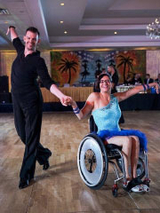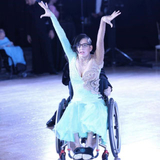Lauren’s Story: Uncovering the Genes that Cause Epilepsy
Lauren’s Story: Uncovering the Genes that Cause Epilepsy
A few weeks ago, Lauren competed at the National Championships for Ballroom Dancing. As a child, she had often dreamt of taking the dance floor at such a high-profile event. The crowd, the applause, the dance, the thrill … in so many ways, it was just as she had imagined it would be. And yet, it was so different.

Growing up, Lauren was an active girl, involved in karate, softball and dance. Then, on the eve of her 10th birthday, she experienced her first seizure and her life changed forever. Lauren began to have multiple seizures a week, her speech slowed, and she had painful involuntary muscle movements called myoclonus. The myoclonus would happen frequently and without warning, causing spasms in her hands, arms, legs and chest, often causing her to fall.
Seemingly overnight, Lauren went from dancing and running around to being dependent on a wheelchair, unable to feed herself or speak. At one point, she couldn’t get out of bed because every time she tried to move, she had a seizure.
About Myoclonus Epilepsy and Ataxia due to KCNC1 mutation (MEAK)
Pathogenic variants (“mutations”) in the KCNC1 gene cause a spectrum of neurological conditions, including a form of progressive myoclonus epilepsy called myoclonic epilepsy and ataxia due to potassium (K+) channel mutation (MEAK).
Lauren’s condition was eventually diagnosed as Myoclonus Epilepsy and Ataxia due to KCNC1 mutation (MEAK), a rare form of genetic epilepsy that is caused by changes in a potassium channel in the brain. She is one of only 20 documented cases in the world and she was the first person diagnosed with MEAK in the U.S.
Raising awareness and funds for life-changing research

There are no known medications or treatments to control symptoms in MEAK, but learning the diagnosis has empowered Lauren and her family. After learning Lauren’s diagnosis, Lauren and her mother, Angela, created a MEAK-focused Facebook page for other families affected by the condition. Since then, they have connected with families all over the world, including five families in the U.S.
One of these families brought Lauren and her family into contact with Katie Helbig, MS, LCGC, Co-Director of Children’s Hospital of Philadelphia’s Epilepsy Neurogenetics Initiative (ENGIN). Helbig and ENGIN Director, Ethan Goldberg, MD, PhD, have a keen research and clinical interest in MEAK. Lauren traveled from her home in Queens, N.Y., to Children’s Hospital of Philadelphia to see Dr. Goldberg and Katie for an evaluation in the ENGIN Clinic and to enroll in their ongoing MEAK research studies. Dr. Goldberg’s research aims to better understand the role of the potassium channel in the brain affected by MEAK and specifically to investigate new treatments that target the underlying mechanism. The hope is that precision treatments may help people with MEAK such as Lauren live more independent lives.
“He is giving us hope,” says Lauren of Dr. Goldberg. “Hopefully within the next year or two, he will find a treatment for me and others like me.”
“We are cautiously optimistic,” adds Angela.
Through the years, we’ve been to many doctors and thought many drugs would help. But I feel like Dr. Goldberg is the closest. He is specifically targeting the gene that’s affecting Lauren and is the most knowledgeable about this particular mutation.
The healing power of dance

When she was 24, Lauren signed up for a wheelchair dance program at a professional dance studio in Manhattan, N.Y. For wheelchair dancing, individuals in wheelchairs are partnered with standing dancers. For the first time since she was 10, Lauren was able to do the sport she grew up loving.
Dance has not only improved her confidence and outlook on life, but it has also had a therapeutic effect. When Lauren began dance lessons, her partner had to hold her by her wrists because any stimulation of her hands triggered myoclonic episodes. Over the past four years, through a lot of hard work, Lauren gradually overcame her sensitivity to touch in her hands. She has progressed from social dancing to solo performances to dance competitions. She now participates in two to three ballroom dance competitions each year. She practices three hours a week, dancing the waltz, tango and foxtrot. Her dances include choreography like chair spins and lifts, and Lauren even gets out of her chair and takes steps with her partner.
“My disability takes a backseat when I’m out on the ballroom floor,” says Lauren proudly. “When I’m dancing, everything else goes away.”
Lauren’s achievements with dance were one of many factors in her recently being crowned Miss Wheelchair New York 2020.
“I hope I inspire others to never give up on their dreams,” says Lauren. “It’s a little harder for someone with physical needs, but it’s definitely doable. Anyone can do anything, you just might have to work a little bit harder.”
The Lauren Arena Foundation for MEAK Research is working to raise funds for Dr. Goldberg’s research. Lauren is also using the platform and publicity that comes with being named Miss Wheelchair New York 2020 to raise greater awareness of MEAK.